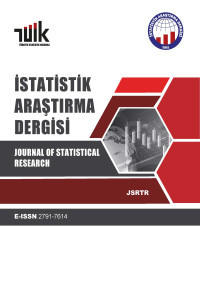Kantil Regresyon Modellerinde Uyum İyiliği Ölçüleri ve Model Seçimi
Bu çalışmada kantil regresyon modellerinde uyum iyiliği ve model seçimi için kullanılan kriterlerden öne çıkanlar bir arada sunulmuştur. Bu kriterler belirlilik oranına (R2) benzer bir ölçü olan R1 oranı, C1 testi, asimetrik ağırlıklandırılmış ortalama mutlak hata (ATWE) ile Akaike (AIC) ve Schwarz (BIC) bilgi kriterleridir. Ayrıca etkinliklerinin arttırılması amacıyla uyarlanmış AIC ve BIC kriterlerine de yer verilmiştir. Bu kriterlerin uygulamada kullanımını göstermek amacıyla, Mincer ücret denklemi desiller düzeyinde yuvalanmış modeller olarak tahmin edilmiştir. Potansiyel tecrübenin karesine kısıt konarak oluşturulan kısıtlı ve kısıtsız modeller için, açıklanan kriterler yardımıyla uyum iyiliği incelenmiş ve model seçimi yapılmıştır. Sonuçta genel olarak kısıtsız model tercih edilmiş ve potansiyel tecrübe ile logaritmik ücret ilişkisinin tüm kantillerde teoride varsayıldığı gibi karesel olması gerektiği belirlenmiştir. Yalnızca uyarlanmış bilgi kriterlerine göre en yüksek kantillerde kısıtlı model tercih edilmiş, yani potansiyel tecrübenin karesinin modelin uyum iyiliğini yüksek kantillerde anlamlı düzeyde arttırmadığı tespit edilmiştir. Kantil regresyon modelleri için topluca sunulan ve uygulamada kullanımı gösterilen uyum iyiliği ve model seçimi kriterlerinin, literatürde daha sonra yapılacak çalışmalar için destekleyici nitelikte olacağı düşünülmektedir.
Anahtar Kelimeler:
Bilgi Kriterleri, Kantil Regresyon, Mincer Ücret Denklemi, Model Seçimi, Uyum İyiliği
Goodness of Fit Measures and Model Selection in Quantile Regression
In this study, the prominent criteria used for goodness of fit and model selection in quantile regression models are presented together. These criteria are the R1 ratio, which is a measure similar to the coefficient of determination (R2), the C1 test, the asymmetric weighted mean absolute error (ATWE), and the Akaike (AIC) and Schwarz (BIC) information criteria. In addition, more efficient AIC and BIC criteria, which were adapted to increase their effectiveness, are also included. To illustrate the practical use of these criteria, the Mincer wage equation was estimated as nested models at the decile level. For the constrained and unconstrained models created by placing constraint on the square of the potential experience, the goodness of fit was examined and the model selection was made with the help of the explained criteria. As a result, the unconstrained model was generally preferred and it was determined that the relationship between potential experience and logarithmic wage should be quadratic in all quantiles as assumed in theory. However, according to the adapted information criteria, the restricted model was preferred in the highest quantiles, that is, it was determined that the square of potential experience did not significantly increase the goodness of fit of the model in high quantiles. It is thought that the goodness of fit and model selection criteria, which are presented collectively for quantile regression models and used in practice, will be supportive for future studies in the literature
Keywords:
Goodness of Fit, Information Criteria, Mincer Wage Equation, Model Selection, Quantile Regression,
___
- Chernozhukov, V. ve Fernández-Val, I. (2005). Subsampling Inference on Quantile Regression Processes. Sankhyā: The Indian Journal of Statistics, 67(2): 253-276.
- Chow, G. (1960). Tests of Equality between Sets of Coefficients in Two Linear Regressions. Econometrica, 28: 591-605.
- Çağlayan-Akay, E. ve Kömüryakan, F. (2021). Koşullu ve Koşulsuz Kantil Regresyon Modelleri Türkiye’de Ücret Eşitsizliği Hakkında Farklı Ne Söylüyor ? Journal of Economy Culture and Society, 64: 1-21.
- Davino, C., Furno, M. ve Vistocco, D. (2014). Quantile Regression: Theory and Applications. West Sussex: John Wiley & Sons, Ltd.
- Dong, C., Li, G. ve Feng, X. (2019). Lack‐of‐Fit Tests for Quantile Regression Models. Journal of the Royal Statistical Society: Series B (Statistical Methodology), 81(3): 629-648.
- Furno, M. (2011). Goodness of Fit and Misspecification in Quantile Regressions. Journal of Educational and Behavioral Statistics, 36(1): 105-131.
- Güriş, S. ve Çağlayan-Akay, E. (2018). Ekonometri Temel Kavramlar. İstanbul: DER Yayınları (5. Baskı).
- Haupt, H., Kagerer, K. ve Schnurbus, J. (2011). Cross-Validating Fit and Predictive Accuracy of Nonlinear Quantile Regressions. Journal of Applied Statistics, 38(12): 2939-2954.
- He, X. ve Zhu, L.-X. (2003) A Lack-of-Fit Test for Quantile Regression. Journal of the American Statistical Association, 98(464):1013-1022.
- Hurvich, C. M. ve Tsai, C. L. (1990). Model Selection for Least Absolute Deviations Regression in Small Samples. Statistics & Probability Letters, 9(3): 259-265.
- Koenker, R. (2005). Quantile Regression. New York: Cambridge University Press.
- Koenker, R. ve Bassett, G. (1978). Regression Quantiles. Econometrica, 46(1): 33–50.
- Koenker, R. ve Machado, J.A.F. (1999). Goodness of Fit and Related Inference Processes for Quantile Regression. J. Amer. Statist. Assoc. 94(448): 1296–1310.
- Machado, J. A. F. (1993). Robust Model Selection and M-Estimation. Econometric Theory, 9: 478–493.
- Mincer, J. (1974). Schooling, Experience and Earnings. New York: National Bureau of Economic Research.
- Pham, H. (2019). A New Criterion for Model Selection. Mathematics, 7(12), 1215: 1-12.
- Shin, W., Kim, M. ve Jung, Y. (2021). Efficient Information-Based Criteria for Model Selection in Quantile Regression. Journal of the Korean Statistical Society, 1-37.
- ISSN: 1303-6319
- Başlangıç: 2002
- Yayıncı: TÜİK
Sayıdaki Diğer Makaleler
Türkiye’de Toplumsal Cinsiyetin Çok Boyutlu Ölçekleme ile İncelenmesi
Kantil Regresyon Modellerinde Uyum İyiliği Ölçüleri ve Model Seçimi
Türkiye'deki Nüfus Artışı ve Nüfus Projeksiyonlarının Ekonometrik Analizi
Türkiye'de Hanehalkı Yoksulluğunu Etkileyen Faktörlerin Belirlenmesi
